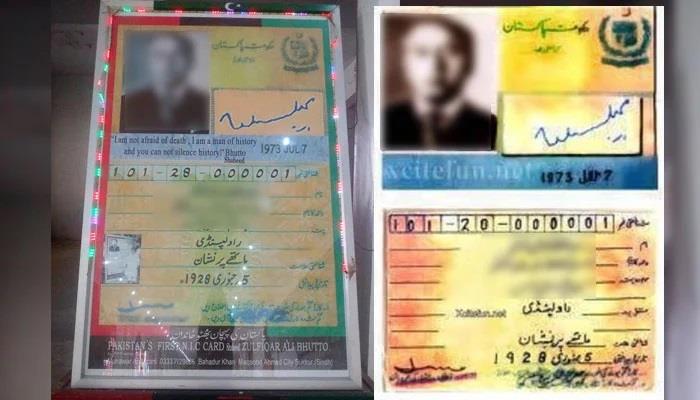
From Bhutto To Biometrics: The Untold Story Of Pakistan's First National Identity Card
The year 1973 marked a significant turning point in Pakistan's history, not only for introducing constitutional changes but also for opening a new chapter in the legal identity of its citizens. That same year, the first National Identity Card (NIC) was issued, based on Article 30(2) of the Constitution, which made it the responsibility of the Election Commission of Pakistan to register citizens and issue them identification at the national level.
Interestingly, no authentic official record exists about who exactly held Pakistan's first identity card.
However, according to historical references and unofficial accounts, this honor is believed to have gone to Prime Minister Zulfikar Ali Bhutto, who was symbolically issued card number 0000001.
At the time, identity cards existed only in paper form, and according to NADRA, the first 100 cards were issued to top government officials and bureaucrats, with Bhutto receiving the very first. Later, ordinary citizens were issued six-digit cards. Although Bhutto is generally considered the first cardholder, this claim is mostly based on tradition, since no official documentation from that era has survived.
The question of who received Pakistan's first women's identity card remains equally uncertain. There is no official confirmation, but historical evidence suggests that Begum Nusrat Bhutto, wife of the then prime minister and a prominent political figure herself, was likely given this distinction. She is believed to have been issued the first female card, possibly numbered 0000002 or close to it.
Also Read: Pakistan Summons Afghan Envoy, Demands Taliban Cut Ties With TTP and Act Against Indian Support
At that time, identity cards were prepared in paper format, and there was no centralized digital database. Some unverified sources also mention Fatima Jinnah, but this is inaccurate since she passed away in 1967, several years before the system was introduced in 1973. Others argue that the first card may have gone to an ordinary woman, though no evidence supports this.
The fact is that neither NADRA nor the Election Commission has any official documents from that era, as much of the record was either lost or left unorganized. NADRA itself was established later, in March 2000, replacing the manual system with digital and biometric ID cards, eventually leading to the introduction of Smart National ID Cards.
An interesting coincidence is that the launch of the national ID card in 1973 coincided with a new wave of Pakistani workers heading abroad for employment. According to the Bureau of Emigration, 13,647 Pakistani citizens legally went overseas that year, mostly to Gulf countries like Saudi Arabia, the UAE, and Kuwait.
This was the period following the global oil crisis, when Gulf states began expanding their construction and energy sectors, creating a sudden demand for Pakistani labor. While irregular migration was also common, it was never properly documented, as only those with visas and labor contracts were officially registered.
According to World Bank data, between 1971 and 1979, about 620,000 Pakistanis migrated abroad for work, and 1973 is seen as the year when this large-scale migration truly began.
Over time, the importance of the identity card grew significantly. Initially, it was only proof of citizenship and residence, but gradually it became essential in nearly every aspect of life. From casting a vote, securing admission to educational institutions, obtaining government jobs, and accessing healthcare and subsidies, the NIC became a basic requirement. In financial activities, it was needed for opening bank accounts, taking loans, purchasing property, or registering vehicles. In legal affairs too-whether court appearances, inheritance claims, or passport applications-the identity card was the first document required.
In the private sector, too, it became indispensable for employment, mobile SIM registration, air travel, and even major purchases. It enabled the verification of individuals, helping curb fraud and crime, while allowing the government to maintain more organized records. Furthermore, Gulf countries and other states came to recognize it as valid proof of Pakistani citizenship.
Thus, the story of Pakistan's identity card began as a symbolic paper document in 1973 and has since evolved into today's advanced biometric and smart ID system. It is not just a card but the ultimate proof of a citizen's legal status, rights, and responsibilities. From education, healthcare, employment, and finance to travel and legal affairs, access is tied to this single document. Protecting it and ensuring its timely renewal is every citizen's duty, for it represents not just identity but also the preservation of one's nationality and legal existence.

Legal Disclaimer:
MENAFN provides the
information “as is” without warranty of any kind. We do not accept
any responsibility or liability for the accuracy, content, images,
videos, licenses, completeness, legality, or reliability of the information
contained in this article. If you have any complaints or copyright
issues related to this article, kindly contact the provider above.
Most popular stories
Market Research

- Nodepay Launches Crypto's Largest Prediction Intelligence Platform
- New Crypto Mutuum Finance (MUTM) Nears $17 Million Raised Ahead Of October
- Ethereum Startup Agoralend Opens Fresh Fundraise After Oversubscribed $300,000 Round.
- Nigel Farage To Headline At UK's Flagship Web3 Conference Zebu Live 2025
- Barunson, Studio Behind Parasite, To Launch Nplug IP Remixing Platform On Story And Bring Flagship IP Onchain
- Solo Leveling Levels Up: Korean Billion-Dollar Megafranchise Goes Onchain With Story




















Comments
No comment